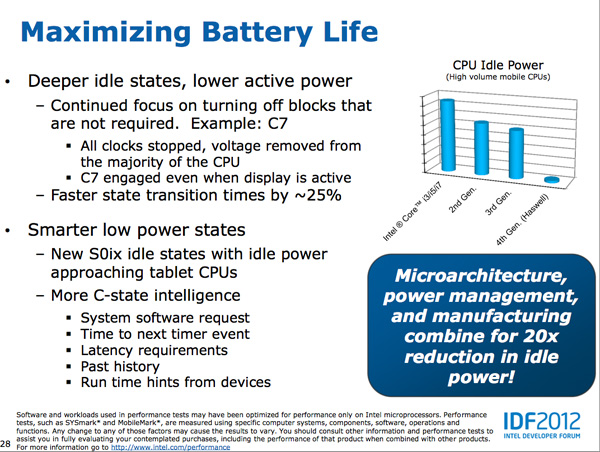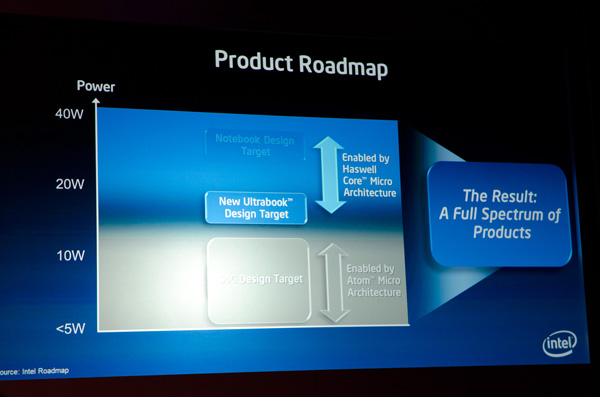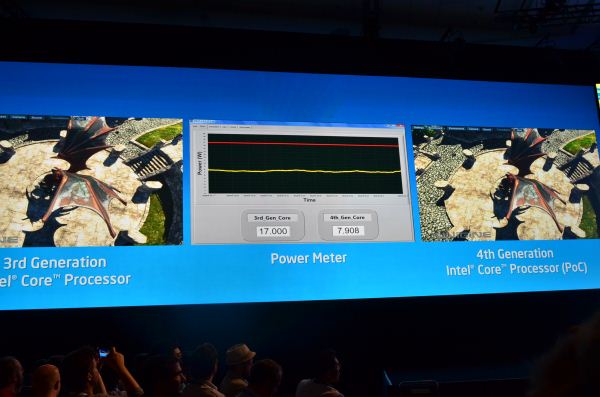Intel's Haswell Architecture Analyzed: Building a New PC and a New Intel
by Anand Lal Shimpi on October 5, 2012 2:45 AM ESTOther Power Savings
Haswell's power savings come from three sources, all of which are equally important. We already went over the most unique: Intel's focus on reducing total platform power consumption by paying attention to everything else on the motherboard (third party controllers, voltage regulation, etc...). The other two sources of power savings are more traditional, but still very significant.

At the micro-architecture level Intel added more power gating and low power modes to Haswell. The additional power gating gives the power control unit (PCU) more fine grained control over shutting off parts of the core that aren't used. Intel published a relatively meaningless graph showing idle power for standard voltage mobile Haswell compared to the previous three generations of Core processors.
Haswell can also transition between power states approximately 25% faster than Ivy Bridge, which lets the PCU be a bit more aggressive in which power state it selects since the penalty of coming out of it is appreciably lower. It's important to put the timing of all of this in perspective. Putting the CPU cores to sleep and removing voltage/power from them even for a matter of milliseconds adds up to the sort of savings necessary to really enable the sort of always-on, always-connected behavior Haswell based systems are expected to deliver.
Intel has also done a lot of work at the process level to bring Haswell's power consumption down. As a tock, Haswell is the second micro-architecture to use Intel's new 22nm tri-gate transistors. The learnings from Ivy Bridge are thus all poured into Haswell. Intel wasn't too specific on what it did on the manufacturing side to help drive power down in Haswell other than to say that a non-insignificant amount of work came from the fabs.
The Fourth Haswell
At Computex Intel's Mooly Eden showed off this slide that positioned Haswell as a 15-20W part, while Atom based SoCs would scale up to 10W and perhaps beyond:
Just before this year's IDF Intel claimed that Haswell ULT would start at 10W, down from 17W in Sandy/Ivy Bridge. Finally, at IDF Intel showed a demo of Haswell running the Unigen Heaven benchmark at under 8W:
The chain of events tells us two things: 1) Intel likes to play its cards close to its chest, and 2) the sub-10W space won't be serviced by Atom exclusively.
Intel said Haswell can scale below 10W, but it didn't provide a lower bound. It's too much to assume Haswell would go into a phone, but once you get to the 8W point and look south you open yourself up to fitting into things the size of a third generation iPad. Move to 14nm, 10nm and beyond then it becomes more feasible that you could fit this class of architecture into something even more portable.
Intel is being very tight lipped about the fourth client Haswell (remember the first three were desktop, mobile and ultra-low-volt/Ultrabook) but it's clear that it has real aspirations to use it in a space traditionally reserved for ARM or Atom SoCs.
One of the first things I ever heard about Haswell was that it was Intel's solution to the ARM problem. I don't believe a 10W notebook is going to do anything to the ARM problem, but a sub-8W Haswell in an iPad 3 form factor could be very compelling. Haswell won't be fanless, but Broadwell (14nm) could be. And that could be a real solution to the ARM problem, at least outside of a phone.
As I said before, I don't see Haswell making it into a phone but that's not to say a future derivative on a lower power process wouldn't.













245 Comments
View All Comments
tim851 - Friday, October 5, 2012 - link
This is a perfect demonstration of the power of competition.With AMD struggling badly, Intel was content in pushing Atom. They didn't want to innovate in that sector, they sold 10 year old technology with horribly outdated chipsets. Yes, they were relatively cheap, but I was appalled.
Step in ARM, suddenly becoming a viable competitor. Now Intel moves its fat ass and tries to actually build something worthwhile.
Sadly, free markets are an illusion. Intel should pay dearly for the Atom fiasco, but they won't. Just as they didn't pay for the Pentium 4 debacle. They will come 5 years late to the party, but with all their might, they will crush ARM. ARM will fall behind, they can't keep up with that viscious tick-tock-cycle. Who can?
In 8 years, ARM will have been bought by some company, perhaps Apple. ARM will then no longer be a competitor, it will be just a different architecture, like X86. I don't see Apple having any long-term interest in designing their own hardware, it's way too unsexy. They will just cross-licence ARM with Intel and in 10 years time, Intel will rule supremely again.
UpSpin - Friday, October 5, 2012 - link
You forget that Intel vs. ARM is something bigger than AMD vs. Intel.Behind ARM stand Qualcomm, Samsung, Apple, ...
All new software is written for ARM, not Intel (x86) any longer. Microsoft releases a rewritten ARM Windows RT with a rewritten Office for ARM. Android runs on ARM and everyone supports the ARM version, while only Intel has to keep it compatible with x86.
Haswell will get released, when exactly? In a year, ARM A15 in maybe two months. Haswell has nice power savings, but it's still a Ultrabook design. The current Atom SoCs are much worse than current A9/Krait SoCs. Intel heavily optimized the software to make it look not that bad (excellent Sunspider results), but they are.
If Windows 8 is a success, Intel can be lucky. If it's not, what many expect, Intel has a real problem.
Intel is a single company building and developing their CPU/SoC. ARM SoCs get build and developed by a magnitude of companies.
If Apple can design their own ARM based SoC which has the same performance as a Haswell CPU (which is easy in the GPU area (the iPad has a faster GPU than the Intel CPUs most probably already, and with A15 and Apples A6 it's possible to get as fast with the CPU, too), they will be able to move Mac OS to ARM. This allows them to build a very very power efficient, lightweight, silent MacBook. They can port apps from iOS to MacOS and vice versa. Because they designed their SoC in-house, they don't have to fear competition the near term.
Apple always wants a monopoly, so it doesn't make sense for them to cross-license anything.
tuxRoller - Friday, October 5, 2012 - link
Unless your app is doing some serious math you can get by with just using a cross platform key chain.Frankly, the hard part is targeting the different apis that are, currently, predominating on each arch. However, assuming those don't change , and the form factor doesn't either, your new app should just be a compile away.
Kidster3001 - Monday, October 15, 2012 - link
Current ATOM SOC's are not "much worse" than A9/Krait. Most CPU benchmarks running in native code will favor the Intel SoC. It's the addition of Android/Dalvik that leans the favor back to ARM. Android has been on ARM for a lot longer and is more optimized for ARM code. Android needs to be tweaked more yet to run optimally on x86.Kidster3001 - Monday, October 15, 2012 - link
" with A15 and Apples A6 it's possible to get as fast with the CPU, too"say what? A15 and A6 are a full order of magnitude slower than Haswell. omg
Dalamar6 - Sunday, May 12, 2013 - link
Nearly all of the software on Android is junk.Apple blocks everything at a whim and gives no control.
I don't know about Windows RT, but I suspect it will suffer the same manner of crap programs Android does if it's not already.
Even if people are more focused on developing for ARM, the ARM OSes are still way behind in program availability(especially quality). And it's downright sad seeing people charging money for simple, poorly coded programs that can't even compare to existing open source x86 software.
jacobdrj - Friday, October 5, 2012 - link
I agree competition is good/great. However, how you categorize Atom is just not true! Atom filled a very real niche. Cheap mobile computing. Not powerful, but x86 and fast enough to do basic tasks. I loved my Atom netbook and used it until it bit the dust last week. Would I have liked more power? Sure, but not at the expense of (at the time) battery life. Besides, once I maxed it out by putting in a SSD and 2 GB RAM, my netbook often outpaced many peoples' newer more powerful Core based laptops for basic tasks like word processing and web browsing.Just because power users were unhappy does not mean Atom was a 'fiasco'. Those old chipsets allowed Atom netbooks to regularly sell, fully functional, for under $200, a price point that Tablets of similar capability are only just starting to hit almost 4 years later...
Don't bash Atom just because you don't fit into it's niche and don't blame Intel for HP trying to oversell Atom to the wrong customers...
Peanutsrevenge - Friday, October 5, 2012 - link
If competition is 'good/great' what does that make cooperation?Imagine the possibility of Intel and AMD working together along with Qualcomm, Imagination etc.....
Zeitgeist Movement.
Kidster3001 - Monday, October 15, 2012 - link
Intel is not going this way because "ARM stepped in". Intel is going this way because it decided to go play in ARMs playground.krumme - Friday, October 5, 2012 - link
My Samsung 9 series x3c (ivy bridge), have a usage looking on this page with wifi at bt on ranging from 4.9W to 9.9W from lowest to higest screen brightness, with a normal usage of screen of 7.2W with good brightness (using samsung own measuring tool).So screen is by far the most important component on a modern machine. In the complete ecosystem i wonder if it matter how efficient Haswell is. The benefit of 10W tdp for say the same performance is nice, but does it really matter for the market effect. And the idle power is already plenty low.
I doubt Haswell will have an significant impact - as nice as it is. This is just to late and way to expensive for the mass market. Those days are over.
At the time it hits market dirt cheap TSMC 28nm A15 and bobcat successor hits the market for next to nothing, and will give 99% of the consumers the same benefits.